10 Years 10 Films (10Y10F) is a project to display embedded YouTube selections of early cinema. This is Part II of a series that gives the viewer a quick time-lapse view of how movie technology and style has developed throughout the world – one clip each year – from 1888 through 2017, starting with the foundations to see how filmmakers build upon or deconstruct them.
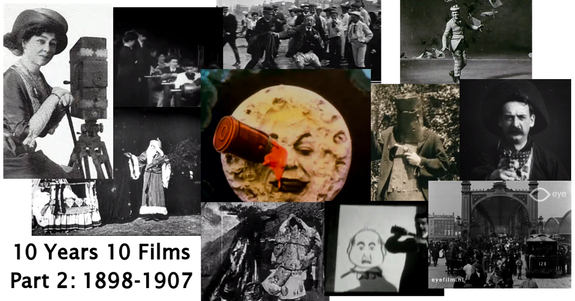
The ten years here in Part II continue what Tom Gunning referred to as a “cinema of attractions”[1], where directors were focused on providing a spectacle (of effects or places around the world) for the viewer, in contrast to telling a unique story with character development and cultural criticism (which became more common as film length increased, around 1906). The merging of vaudeville theaters and Nickelodeons from 1905 to around 1912 brought movies to the masses – in Part III, we’ll see the adoption of the movie “star system,” the feature film business, African American movie makers, and more women directors.
On a personal note, while digging in to Part II, I’ve been overwhelmed by the variety of websites and film societies out there. It is surprisingly difficult to find accurate information and even more difficult to find video clips beyond what was being produced in the US, UK, and France before 1908. Polish film theoretician and photographer, Bolesław Matuszewski, suggested a museum of filmed images in 1898, but no one bothered to do anything like that until the mid-1930s.[2]
Click on the Expand arrow for more details and additional films of note for that year. Disclaimers and the YouTube playlist of the 10 films highlighted here are at the end of this post.*
10Y10F Series:
I 1888-1897, II 1898-1907,
III 1908-1917, IV 1918-1927,
V 1928-1937, VI 1938-1947,
VII 1948-1957 …
/ Collapse All ˄
1898 – Santa Claus (Smith; England)
A simple tale of children going to bed on Christmas Eve. This film is believed to be the first use of parallel action as Santa appears superimposed on the right side of the screen, descending the chimney and appearing in the childrens’ room. Expand
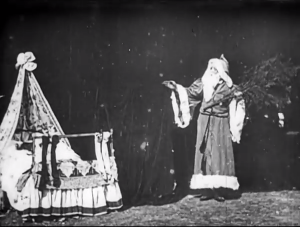 1min. George Albert Smith. Brighton, England.
1min. George Albert Smith. Brighton, England.
Other film(s): Four Heads Are Better Than One (Un homme de têtes) (1min. Paris, France.) The multiple exposure effects in this Georges Méliès film are still impressive more than 100 years later.
World events in 1898: New York City annexes land (and divides into five boroughs), making it 2nd largest city in the world. The Spanish-American War begins. Pepsi-Cola named. Two man-eating lions in Kenya are killed, inspiring several films such as The Ghost in the Darkness (1996). Russian director Sergei Eisenstein born.
1899 – Maple Leaf Viewing (Shibata; Japan)
Taira no Koremori defeats a demon who has disguised itself as Princess Sarashina. This oldest known extant Japanese film is a record of the kabuki actors Onoe Kikugoro V and Ichikawa Danjūrō IX performing a scene from the play Momijigari. Expand
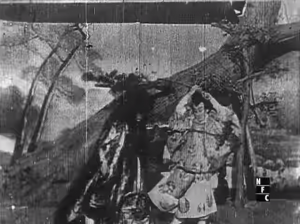 Momijigari. 5min. Tsunekichi Shibata. Tokyo, Japan.
Momijigari. 5min. Tsunekichi Shibata. Tokyo, Japan.
Other film(s): Somersaults (Les krémos: Sauts perilleux or Les Krémo à Paris (acrobates) or V. Pyramide) (40sec. Paris, France.) A fun Lumière film featuring impressive acrobats.
World events in 1899: Spanish rule ends in Cuba. Scott Joplin’s Maple Leaf Rag registered for copyright. Births: British director Alfred Hitchcock and American actress Gloria Swanson.
1900 – The Enchanted Drawing (Blackton; New Jersey)
Blackton, a cartoonist, is photographed in Thomas Edison’s “Black Maria” studio performing a vaudeville routine known as the “lightning sketch,” supplemented by stop-camera tricks that bring the drawn objects to life. (I was hoping to find a new century celebration on film, but no luck so far. Let me know in the comments if you know of anything like that!) Expand
Other film(s): Soldiers of the Cross (Approx. 22min. Australia.) Herbert Booth illustrated lecture, combining photographic glass slides with short dramatised film segments and live music to relate the stories of early Christianity. While none of the films have survived, this is considered the first long narrative motion picture. Details and photos of the glass plates at the National Film and Sound Archive of Australia (NFSA).
World events in 1900: Height of the Boxer Rebellion in Beijing, China. The Paris Exposition Universelle world’s fair hosted the first Olympic Games outside of Greece. Actress Helen Hayes, the “First Lady of American Theatre,” born.
1901? The Maasbrug in Rotterdam (Nöggerath? Netherlands)
A well-preserved slice of life in Holland, showing people and horse-drawn trolleys in front of the ornamented Maasbrug bridge. This is one of many films on the EYE Film Institute of the Netherlands YouTube channel. Film historian Klaux Kreimeier has collected dozens of films from this era on his website. Expand
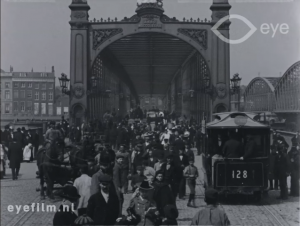 De Maasbrug te Rotterdam Omstreeks 1901. 85sec. Filmfabriek F.A. Nöggerath (“Film Factory” production company led by F.A. Nöggerath, Sr.). Amsterdam, Holland.
De Maasbrug te Rotterdam Omstreeks 1901. 85sec. Filmfabriek F.A. Nöggerath (“Film Factory” production company led by F.A. Nöggerath, Sr.). Amsterdam, Holland.
Other film(s): President McKinley’s speech at the Pan-American Exposition (80sec. Edison Films. Buffalo, New York.) While there is no audio available, it is one of the best quality films of William McKinley available, and just a day before his assassination at the fair. To hear his voice, there is an 1896 wax cylinder recording – apparently the only audio of the president available.
Star Theatre (aka Demolishing and Building Up the Star Theatre) (70sec. F.S. Armitage. New York City.) A time-lapse special effects film showing the demolition of the Star Theatre at the corner of Broadway and Thirteenth Street. According to publicity from the production company, “a specially devised electric apparatus” took single exposures every four minutes, within brief normal-speed views at the film’s start and close. The full title seems inexplicable—we see only demolition—until one reads Biograph’s recommendation to exhibitors that the film also be run backward. More film notes at the NFPF.
World events in 1901: The Commonwealth of Australia established. In the first great Texas gusher, oil is discovered at Spindletop. William McKinley sworn in for a second term as U.S. President, but is assassinated in September – VP Theodore Roosevelt becomes the 26th President. New York becomes first state to require automobile license plates. Births: Walt Disney, German-American actress Marlene Dietrich, American trumpeter and actor Louis Armstrong.
1902 – A Trip to the Moon (Méliès; France)
A group of astronomers go on an expedition to the Moon and back. This is well known as the first major motion picture, particularly in the science fiction genre. The 2011 re-release is arguably the most impressive movie restoration job available today with a number of special features on the DVD/Blu-ray (which includes a new documentary and two versions of the film – one in original color tinting w/ an ethereal new soundtrack by Air). Expand
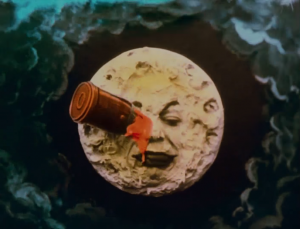 Le Voyage dans la Lune. 13min. Georges Méliès. Montreuil, Paris. The version posted here includes a new piano score.
Le Voyage dans la Lune. 13min. Georges Méliès. Montreuil, Paris. The version posted here includes a new piano score.
Other film(s): Miss Dundee and Her Performing Dogs (Les chiens savants. 3min. Alice Guy. Buttes-Chaumont, Paris.) Made during Guy’s tenure as head of production (1896-1906) at Gaumont, the oldest (and still-operational) studio in the world.
World events in 1902: Internal combustion engine land speed records pass 75 mph. The US wins Philippine-American War, which began in 1899 as a consequence of the Spanish-American War. The “teddy bear” created, inspired by President Roosevelt’s bear hunt. Edward VII crowned king of the UK. German filmmaker Leni Riefenstahl born.
1903 – The Great Train Robbery (Porter; New York City)
A group of bandits stage a brazen train hold-up, only to find a determined posse hot on their heels. This is widely considered the first American action film, and like A Trip to the Moon, one of the greatest movies in the first 20 years of cinema. No other films until 1915’s The Birth of a Nation made a more significant impact than these two. (I find it interesting that all three of these films were inspired by a play, books, or other films. Ironically, moviegoers today tend to complain about “nothing original” being made anymore.) Expand
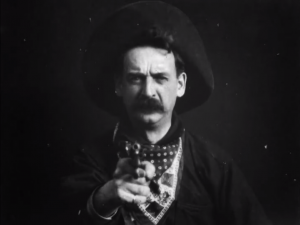 13min. Edwin S. Porter. Filmed in various locations throughout New Jersey and Edison’s studio in Manhattan.
13min. Edwin S. Porter. Filmed in various locations throughout New Jersey and Edison’s studio in Manhattan.
Other film(s): Alice in Wonderland (9min. Cecil Hepworth & Percy Stow. Walton-on-Thames, England.) The first film adaptation – and the longest English movie at the time at 12 minutes, 3 of which have been lost – of Lewis Carroll’s 1865 children’s book. Timothy John Sharp has a funny write-up of all Alice films through 1999.
World events in 1903: First west-east transatlantic radio broadcast. First Tour de France bicycle race. The Wright brothers make their first powered flight.
1904 – Westinghouse Works (Bitzer; Manhattan)
A collection of 21 short films, each averaging about three minutes in length. The films were taken in April and May 1904 and document various Westinghouse manufacturing plants. G. W. “Billy” Bitzer directed the films and later became known for his lifelong association with D. W. Griffith, director of The Birth of a Nation (1915). Expand
Other film(s): An Interesting Story (4min. Williamson. England.) A comedy in which we follow a man so engrossed in his book he is dangerously oblivious to what happens around him which results in some funny accidents and mishaps. Directed by James Williamson, a Scottish-born chemist who was also involved in the “Brighton School” of film pioneers.
World events in 1904: Start of the Russo-Japanese War. Americans pick up where French left off in the construction of the Panama Canal. Olympic Games are held in St. Louis. Peter Pan debuts as a London play. Cy Young pitches the first perfect game in professional baseball. English actor Cary Grant born.
1905 – The Misadventure… (Mullens; Netherlands)
A bather (played by the director Willy Mullens) lounging in a beach chair is surprised by a sudden onset of water. He quickly pulls his pants off to keep them dry. A policeman is not appreciative and trouble grows, witnessed by a growing crowd. The bather tries to escape by disguising himself as a woman, and flees across the village but is eventually caught by the collar. A crowd of people and a musical band accompany his arrest. Tristan Ettleman at Medium has a great series highlighting five films a year, including The Misadventure; he describes this as the precursor to “Jackass” guerrilla filmmaking. Expand
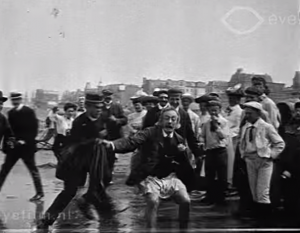 Full title: The Misadventure of a French Gentleman Without Pants at the Zandvoort Beach (De Mésaventure van een Fransch heertje zonder pantalon aan het strand te Zandvoort). 5min. Willy Mullens. Zandvoort, Holland.
Full title: The Misadventure of a French Gentleman Without Pants at the Zandvoort Beach (De Mésaventure van een Fransch heertje zonder pantalon aan het strand te Zandvoort). 5min. Willy Mullens. Zandvoort, Holland.
Other film(s): Rescued by Rover (6min. Cecil Hepworth &
Lewin Fitzhamon. Buffalo, New York.) A dog leads its master to his kidnapped baby. Director Hepworth’s family dog, Blair (who also made an appearance in the aforementioned Alice in Wonderland), became a household name due to the popularity of this film. Two of the actors were paid to appear – likely an industry first. Rescued By Rover marks possibly the only point in film history when British cinema unquestionably led the world. It marks a key stage in the medium’s development from an amusing novelty to the “seventh art,” able to hold its own alongside literature, theatre, painting, music and other more traditional forms.
World events in 1905: Harry Davis and John P. Harris popularize the Nickelodeon movie theater concept, increasing demand for more foreign films (particularly from France) as American production companies could not make movies fast enough. Russo-Japanese War ends, sparking the 1905 Russian Revolution; Teddy Roosevelt wins the Nobel Peace Prize as mediator. Albert Einstein’s Annus Mirabilis papers published. Births: Swedish-born actress Greta Garbo, American actors Joan Crawford and Henry Fonda.
1906 – The Story of the Kelly Gang (Tait; Australia)
The last days of Ned Kelly (1854-1880), Australia’s most notorious outlaw. The version of the film posted here (about 16 minutes plus notes from the “study version”) is the most complete collection of found footage, pieced together from 1975-2006. The original film was over an hour long and considered the world’s first feature-length narrative film. The National Film and Sound Archive of Australia has a great write-up about the 2006 restoration, and also sells it in Blu-ray and DVD on their website. (I would love to get a hold of the 204-page book released with the 2007 DVD – apparently a different release than the one currently in the NFSA shop. This is one of the most interesting films I’ve found during my 10Y10F research – mainly due to the subject matter and how the film was made, not so much the plot and cinematography.) Expand
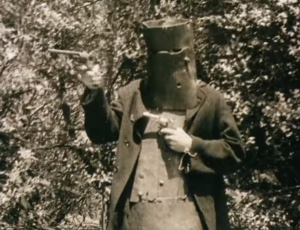 32min. Charles Tait. Melbourne, Australia.
32min. Charles Tait. Melbourne, Australia.
Plot details: Wikipedia briefly outlines six “scenes” from the film, but I have yet to find any full written details anywhere online, so I’ve taken the liberty of shorthand transcribing the “study version” of the film embedded here. Text in brackets is of the missing material. Expand
1. [Police come to Kelly home with a warrant for Dan’s arrest. Kate rides off to warn him, but Constable Fitzpatrick follows. She returns, warning about troopers wanting to arrest Dan. Fitzpatrick arrives and starts trouble,] but Kate tries to stop him, along with others in the gang. Ned shoots Fitzpatrick in the arm and escapes with the gang while Kate holds him at gunpoint. [In the Wombat Ranges the gang discuss what they will do next.] Brief scene of them on horseback talking. [Contables Kennedy and Scanlon leave the Stringybark Creek police camp in the Wombat Ranges in search of a new campsite.]
2. MacIntyre and Lonergan remain behind to shoot parrots, which alerts the gang. [Lonergan is shot and MacIntyre taken prisoner.] The gang make tea as Hart rushes back to alert that Kennedy and Scanlon are returning. Ned tells MacIntyre that Lonergan was shot in self defence. A shootout encurs and MacIntyre escapes. [The gang declared outlaws (£8,000) for shooting Fitzpatrick. (Screenshot of bill posted on a tree with gang reading it.)]
3. 8-minute segment: They enter driveway of Younghusband’s station on right side of frame, and knock on the door on left side of frame. They rob the men and several other groups and individuals arriving at the station, disguising themselves in their clothes. [They stick up Euroa Bank and return to the station with prisoners from the bank. (Two screenshots of robbery.) At Younghusband’s, Ned gives Hart a bag of money and he rides off with it.
4. Kate is chased by troopers as she spreads the news of incoming police reinforcements. (Screenshot of Kate.) Queensland trackers are part of the reinforcements, hunting the gang in the Strathbogie Ranges. (Two screenshots of trackers.) Kate’s sister leads police on a wild goose chase while carrying a package of supplies for the gang, which they find out is only filled with empty bottles and stones. Mrs. Byrne overhears Sherritt betraying the gang to the police. She informs Kate & her sister, which decide to warn Ned. They’re chased by a trooper but escape while crossing a creek. (Several screenshots.) Joe and Dan capture Farmer Wicks upon hearing about Sherritt’s betrayal. They lure Sherritt and the police into the farmer’s hut. As Sherritt goes to the door, Byrne (his old schoolfellow) shoots him dead. (Two screenshots of shooting.) The police hide under the bed and Mrs. Sherritt is taken hostage. The gang raid the police station at Jerilderie and lock up Constables Devine and Richards. They put on police uniforms and force a policeman to introduce them to residents as they parade down the street. Dan Kelly climbs a telegraph pole and cuts wires, preventing communication. (Screenshots of pole.)
5. The gang captures the platelayers and forces them to tear up the railroad bringing police reinforcements. (Screenshots of railroad destruction.) They’re then brought to the Glenrowan Hotel. Inside, Curnow the schoolmaster reveals that the stationmaster has a gun, which the gang takes from him. Curnow gets away and risks his life in the dead of night to stop the train.] 4-minute segment: The gang are unaware that the train is saved – shots are fired into the hotel as he’s giving a toast of revelry. They spring into action – the son of Mrs. Jones the hotel’s owner, is killed, as well as Joe. Police surround the hotel as the gang return fire from the veranda. The police set fire to the hotel despite Father Gibney’s protest that there are women and children inside. Red tint: Steve and Dan “die by each other’s hands;” Gibney rescues a platelayer.
6. [Ned Kelly escapes into the night.] Two minutes of fragments: He returns to attempt rejoining his comrades, heavily armored. The police shoot at him as he approaches from the bushes. His left hand and then legs are shot. He begs the police to spare his life and they take him away.
Other film(s): Humorous Phases of Funny Faces (4min. J. Stuart Blackton. New York.) A title screen gradually appears in animated lettering, followed by the appearance of a hand drawing a series of funny characters: two faces, a man with an umbrella, two faces in profile, and a clown. The second segment here may have been filmed a year later. It shows the stereotypical faces of “Coon and Cohen,” the profile of a seated man, and a bottle of Medoc. This is considered the first animation on “standard” film stock (35mm nitrate at this time).
A Trip Down Market Street Before the Fire (13min. Harry Miles. San Francisco, CA.) Less than a month before the city’s devastating earthquake and fire, this film was shot by placing a camera on the front of a moving cable car as it traveled from 8th Street all the way to the turntable at The Embarcadero.
World events in 1906: Mahatma Gandhi coins the term Satyagraha to characterize the nonviolence movement in South Africa. Upton Sinclair publishes The Jungle, a novel exposing the harsh conditions for immigrant workers in American, particularly in the meatpacking industry. Eruption of Mount Vesuvius in Italy. Births: Austrian-American filmmaker Billy Wilder; actress Mary Astor, and director/actor John Huston, both American.
1907? Dranem Performs ‘The True Jiu-Jitsu’ (Guy; France)
The famous French “interpreter,” Dranem, sings “The True Jiu-Jitsu” in this phonoscène (music video). This was a technology that synchronized pre-recorded audio to video of the singer(s) lip-syncing. A short making-of film of Guy directing performers for a phonoscène is also available on YouTube. Expand
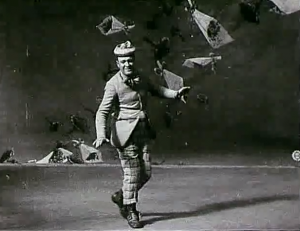 Le vrai jiu-jitsu. 2min. Alice Guy. Paris, France. Chronophone sound recording with chronograph. More details on this French website.
Le vrai jiu-jitsu. 2min. Alice Guy. Paris, France. Chronophone sound recording with chronograph. More details on this French website.
Other film(s): The House of Ghosts (La maison ensorcelée. 6min. France.) Segundo de Chomón primarily worked in Barcelona, but made a name for himself directing shorts in France and later doing effects for Italian epics such as Cabiria and Maciste in Hell. The House of Ghosts is a near-shot-for-shot remake of J. Stuart Blackton’s Haunted Hotel from earlier that year (both featuring innovative stop-motion), but De Chomón films have a unique, signature creepiness.
Life and Passion of Christ (La vie et passion de notre seigneur Jésus-Christ. 44min. Lucien Nonguet & Ferdinand Zecca. France.) Over 30 vignettes of traditional “life of Christ” and “Passion Play” material. France’s successful Pathé studio updated their Life and Passion films continually, which has created confusion on identifying the primary versions released in 1899, 1902-1905, 1907, and 1913. The version shown here is from a 1907 copy, as confirmed by matching screenshots from The Timeline of Historical Film Colors. The aforementioned Segundo de Chomón developed Pathécolor, which he used in this film; he also acted as cinematographer. For recent research and screenshots of the various versions, take a look at the Google Preview of The Silents of Jesus in the Cinema (1897-1927), a book edited by David Shepherd in 2016. A slightly-lower-quality copy of Life and Passion is also on Archive.org.
World events in 1907: Variety magazine (founded in 1905) publishes what is considered the first film reviews. Robert Baden-Powell leads the first Scout camp in England. The first New Years “ball drop” is held in Times Square. Births: English actor Laurence Olivier, American actors John Wayne and Katharine Hepburn.
* DISCLAIMERS
These “silent” films were usually accompanied by live music, narration, and/or sound effects – improvised, compiled from cue sheets of common themes, or more commonly in the 1900s original score. It’s hard to tell if the sound accompanying any of the clips in this post (other than Jiu-Jitsu) were intended by the original director – film credits did not exist until 1912. And precise details on the films are hard to come by, even in the history books, much less the repeated misinformation on the internet.
I will attempt to keep these videos up to date as YouTube videos tend to disappear from time to time. Most of the screenshots that I’ve posted are from the original videos when this was created in February 2018. I’ve captured a copy of the original page on Archive.org for comparison.
Other than a couple of classes in college involving film, I fully admit to having no professional training in cinema history. Please let me know if any corrections need to be made, or if you have any other feedback. I usually respond pretty quickly to comments on this site.
YouTube playlist: Part 2 10Y10F: 1898-1907
Endnotes
1 Gunning, Tom, “The Cinema of Attraction: Early Film, Its Spectator and the Avant-Garde,” Wide Angle, Vol. 8, nos. 3 & 4 Fall, 1986: pp. 63-70. [PDF]
2 Matuszewski, Bolesław, “A new source of history: the creation of a depository for historical cinematography,” 1898. 2014 review in English. In French: Archive.org original pamphlet and a biographical study of Matuszewski from 2004.
10Y10F Series:
I 1888-1897, II 1898-1907,
III 1908-1917, IV 1918-1927,
V 1928-1937, VI 1938-1947,
VII 1948-1957 …
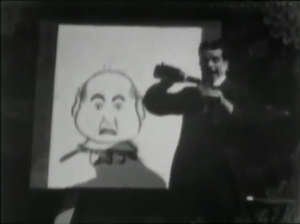
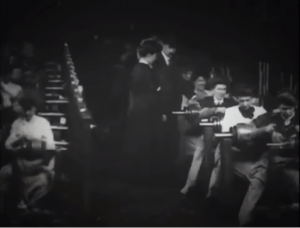
Comments
7 responses to “Video clips and history of world cinema: 1898-1907”
[…] Here is the list of films we are discussing this week: http://zepfanman.com/2018/02/videos-world-cinema-1898-1907-10y10f2/ […]
[…] Series: I 1888-1897, II 1898-1907, III 1908-1917, IV 1918-1927, V 1928-1937 […]
[…] Series: I 1888-1897, II 1898-1907, III 1908-1917, IV 1918-1927, V […]
[…] Series: I 1888-1897, II 1898-1907, III 1908-1917, IV 1918-1927, V […]
[…] Series: I 1888-1897, II 1898-1907, III 1908-1917, IV 1918-1927, V […]
[…] Series: I 1888-1897, II 1898-1907, III 1908-1917, IV 1918-1927, V 1928-1937, VI 1938-1947 […]
[…] Series: I 1888-1897, II 1898-1907, III 1908-1917, IV 1918-1927, V 1928-1937, VI 1938-1947, VII 1948-1957 […]